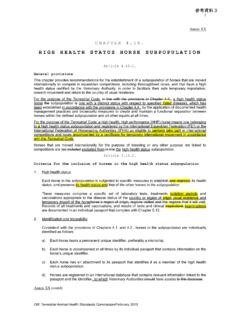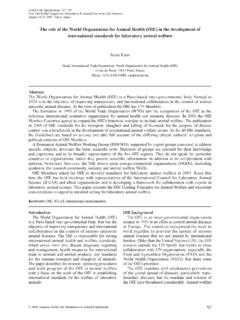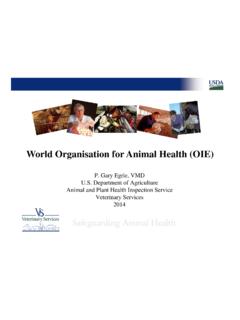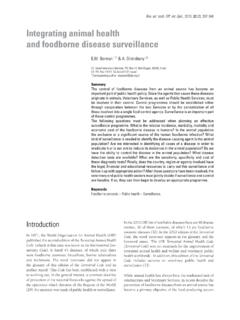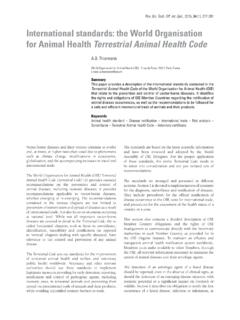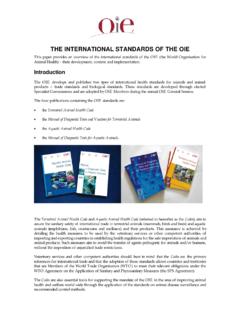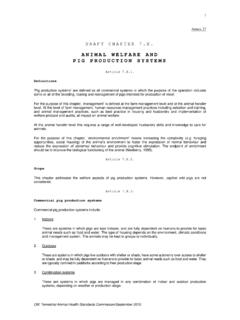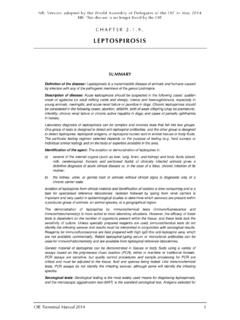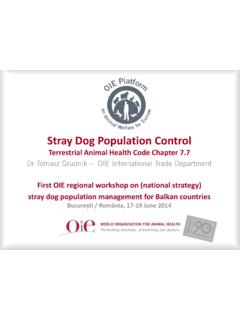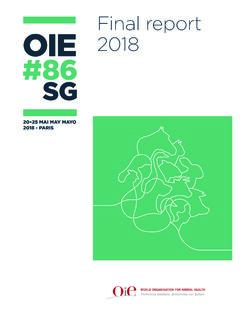Transcription of OIE standards and guidelines related to trade and poultry ...
1 11 The World Organisation for animal health : OIE standards and guidelines related to trade and poultry diseasesChristianne Bruschke and Bernard VallatWorld Organisation for animal health , 12, Rue de Prony, 75017 Paris, the difficulty faced by some countries in fully eradicating animal diseases from their territories as a whole, or to maintain animal disease-free status in parts of their national territories, the World Organisation for animal health (OIE) has introduced the concepts of zoning and compartmentalization for purposes of disease control and interna-tional trade , in the terrestrial animal health Code. Compartmentalization is based mainly on functional separation by biosecurity measures, whereas zoning is based mainly on geo-graphical separation. Relevant animal subpopulations should be clearly defined, recogniz-able and traceable, and should be epidemiologically separated from other subpopulations. Veterinary authorities as well as the private sector have important responsibilities in the establishment and maintenance of words: OIE, standards , guidelines , compartmentalization, zoning1 IntrOductIOnThe World Organisation for animal health (OIE)1 is an independent intergovernmental organization founded in 1924, and having 172 member countries in January 2008.
2 OIE s mandate is to improve animal health worldwide. The organization achieves this mandate through its six primary objectives, which include ensuring transparency in the global animal disease situation, permanent update of disease prevention and control methods, provision of international solidarity in the control of animal diseases, publication of international ani-mal health standards , and improvement of the legal framework and resources of veterinary services. For several years, the OIE has also had a strong focus on improving animal pro-duction food safety and animal welfare. OIE s headquarters are in Paris (France), and there are nine regional offices in the five regions. The OIE now has two regional animal health centres operating in collaboration with FAO, based in Bamako and Beirut, and is planning to establish other centres that will serve as regional centres of order to fulfil the mandate to ensure transparency in the global animal disease situ-ation, the OIE manages the World animal health Information System (WAHIS)2, based on poultry in the 21st Century2the commitment of member countries to notify the main animal diseases, including zoon-oses, to the OIE.
3 In 2004, OIE member countries approved the creation of a single list of diseases notifiable to the OIE to replace the former lists A and B. The content of the list is based on a decision tree which is part of the terrestrial animal health Code. Currently, about one-hundred diseases are listed; thirteen of these are poultry diseases, among which are highly pathogenic avian influenza (HPAI), Newcastle disease, Marek s disease, infectious bursal disease and avian infectious outbreaks of all listed diseases should be officially notified to the OIE central bureau within 24 hours, and regular update reports should be provided on the outbreak situation. The information is immediately disseminated to the delegates of all member countries, who can use it to analyse the risk of introduction of diseases into their own countries. Mem-ber countries must also provide six-monthly reports on their animal disease situation. The World animal health Information Database (WAHID) interface provides access to all data held within WAHIS4.
4 The OIE animal health information department actively approaches delegates to verify unofficial information on outbreaks of animal diseases in member coun-tries. In the Global Early Warning and Response System (GLEWS), a cooperative mechanism between OIE, FAO and WHO, the official and unofficial outbreak information of the three organizations is shared to allow better intervention, better analysis of data and more tar-geted capacity-building in relevant member the international standard-setting body for animal health , the OIE has defined stand-ards on notification, trade aspects and surveillance of the listed diseases, including the poultry diseases. The aim of the terrestrial animal health Code5 is to ensure the sanitary safety of international trade in terrestrial animals and their products, by detailing the health measures to be used by the veterinary services of importing and exporting countries. The measures are also meant to avoid the transfer of pathogenic or zoonotic agents without imposing unjustified trade OIE is in a continuous process of updating its disease standards , while taking into account the latest scientific information on the diseases.
5 For example, the chapter on avian influenza in the terrestrial animal health Code was updated in 2004. The new chapter has several significant changes compared to the previous one, such as differentiating between low and highly pathogenic avian influenza and defining HPAI as an infection of poultry . The chapter gives trade recommendations for poultry and poultry products like fresh meat, meat products, eggs, feathers and down. The terrestrial animal health Code also provides general guidelines for surveillance and specific guidelines by specific disease standards are further defined in related chapters, appendices and definitions, which include: standards for surveillance that have to be met if countries are to declare freedom from disease; standards for conducting risk assessments; humane meth-ods for killing animals if stamping-out of infected populations is necessary; methods for disposal of dead animals; biosecurity standards for poultry establishments; standards for 2 The World animal health Information System, WAHIS: Sixteenth edition, 2007, available at standards and guidelines related to trade and poultry diseases3the inactivation of viruses; and definitions of infected and uninfected as applied to a country, zone or compartment.
6 The OIE also publishes guidelines on the use of vaccination, when relevant ( for avian influenza prevention and control).The Code is accompanied by the OIE Manual of Diagnostic Tests and Vaccines for Terres-trial Animals (referred to hereafter as the Manual)6, which outlines a harmonized approach to disease diagnosis by describing internationally agreed laboratory diagnostic techniques. The instructions in the Manual should be followed in order to allow comparison between results from different laboratories in different countries; for this purpose, quality systems should be implemented in laboratories. The Manual also gives general guidelines on prin-ciples for the quality of veterinary vaccine production and guidelines for the development, production and use of disease-specific avIan InfluEnza and nEwcaStlE dISEaSEThe spread of the current HPAI strain H5N1 has given rise to an unprecedented situation over the past few The disease has important economic and social consequences in affected countries, and humans may be infected due to its zoonotic nature.
7 An important risk is the possible development of a human pandemic virus by mutation or recombination with a human influenza OIE strategy focuses on eradication at the animal source through the following key actions: early detection; early warning; rapid confirmation of suspects; rapid response; and rapid and transparent notification. The main goal is to reduce the virus load and circula-tion in poultry and spread to unaffected areas or countries, and therewith also decrease the risk of human infections or the development of a human pandemic virus (FAO and OIE in collaboration with WHO, 2007). High-quality veterinary services complying with OIE standards , legislation and a clear national chain of command are the basis of animal disease control and ,9 Important constraints to the effective control of animal diseases exist in developing and transition countries, as many of these countries have weak or non-existent veterinary services.
8 Newcastle disease is a disease of poultry that is endemic in many parts of the world, and is an important differential diagnosis for HPAI, as the dis-eases can not be differentiated clinically. Most areas affected by HPAI are also affected by endemic Newcastle disease infections with high mortality in poultry . Many countries have expressed an interest in introducing the concepts of zoning and compartmentalization for these two zOnIng and cOmpartmEntalIzatIOnRecognizing the difficulty that some countries have in eradicating animal diseases from their territory as a whole and in maintaining an animal disease-free status, the OIE has introduced the concepts of zoning (Figure 1 below) and compartmentalization (Figure 2 below) for purposes of disease control and international trade , in the terrestrial animal 6 Fifth edition 2004: The OIE Avian Influenza Website: Capacity-building of veterinary services: The new tool for evaluation of veterinary services (PVS Tool) using OIE international standards of quality and evaluation: in the 21st Century4 health Code.
9 Utilizing these concepts, countries may eradicate a disease from only a part of their territory while the country as a whole is not yet free of the disease. Countries can do this by defining an animal subpopulation with a distinct health status ( free from a certain disease ) within its boundaries. They may then resume trade from this part of the terri-tory. Compartmentalization is defined as one of more establishments under a common biosecurity management system containing animals with a distinct health status , and is therefore based on a functional separation. Zoning applies to animals with a distinct health status on the basis of geographical separation. Zoning has been used regularly by countries in their disease eradication programmes, whereas compartmentalization is a relatively new concept. Both concepts allow concentration of personnel and financial resources where there is greatest chance of success in controlling or eradicating the disease and in gaining or maintaining market access for certain international standards on zoning and compartmentalization can be found in Ter-restrial animal health Code Chapter on Zoning and Compartmentalization.
10 The General guidelines on the Application of Compartmentalization are currently under development and should be added as an appendix to the terrestrial animal health Code in 2008 after endorsement by the OIE international countries that wish to quickly implement compartmentalization for avian influenza and Newcastle disease as part of their disease control programmes, the OIE has developed a checklist on the practical application of the concept. This checklist is not yet part of the terrestrial animal health Code, but can be found on the OIE To implement zon-ing or compartmentalization, other factors like strong veterinary services, a good identifica-tion and traceability system, and good surveillance programmes are crucial. Relevant infor-mation on these issues can also be found in the terrestrial animal health Code: Chapters 10 See Footnote INFECTEDINFECTEDFREE riverbufferzonebufferzonemajor roadrailwayFigure 1the concept of zoningOIE standards and guidelines related to trade and poultry and : Evaluation of Veterinary Services; Appendix : General Principles for the Identification and Traceability of Live Animals; Appendix : General guidelines on animal health Surveillance; and Appendices on disease specific OIE feels that the time is right to emphasize the possibility of introducing the con-cepts of zoning and compartmentalization in disease eradication programmes.










